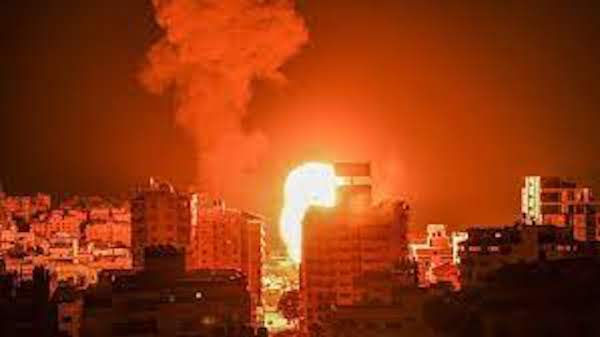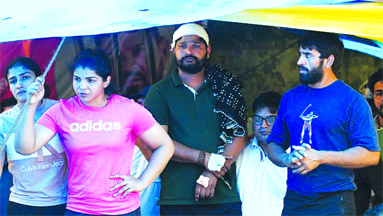

Israel will have to introspect. Its hardline, extreme-right approach is pulling it into a black hole. The prospects of Hamas East and West, Hezbollah to the North and restive Palestinians within the country do not bode well for the long-term security and prosperity of its populace. When asymmetric entities engage in conflict, outcomes are unpredictable. Rocket salvo attacks by Hamas have broken through the Israeli Iron Dome, challenging its invincibility.
Let there be no strife, I pray thee, between me and thee, and between my herdsmen and thy herdsmen; for we be brethren. — Abraham, Old Testament
RAMZAN’S Laylat al Qadr, the Night of Destiny, catapulted Israel and Palestine to a crescendo of violence. With more than 200 killed in Gaza and at least 10 in Israel, the battle has entered its second week. Hamas, having fired about 3,000 rockets in salvos, and relentless Israeli air, land and sea bombardments on hundreds of targets are edging the protagonists towards an expanded conflict.
The combat comes at a time when Israeli Premier Benjamin Netanyahu and Palestinian President Mahmoud Abbas are both in political quicksand. Netanyahu may gain a lifeline as his opponent Yair Lapid is unable to engineer support. President Abbas will, however, sink deeper, ceding vital space to Hamas. Al Fatah and Hamas took birth in the Palestinian Intifada of 1987. While Fatah and Arafat took center stage in the Palestine Liberation Organisation (PLO), Hamas unrelenting, fundamentally divergent, bided its time. Post elections in 2006, Hamas expelled Fatah from the Gaza Strip, resulting in a fractured Palestinian Authority: Hamas in Gaza and Fatah in Palestine territories, to the East of Israel.
The conflict between Hamas and Israel is endemic, manifesting itself in the wars of 2009 and 2014. The present firestorm was preceded by a slow but definite burn. Stoking the fires of Palestinian resentment have been the US-supported declarations on Jerusalem, the Golan Heights and the ill-conceived Trump ‘Deal of the Century — Peace Plan’.
The night of May 8 was nestled in an unfortunate convergence of emotive triggers: Heavy Israeli hand in crowd management for Ramzan; Israeli celebrations of their 1967 victory and capture of East Jerusalem; and Israeli Court permitting the eviction of four Palestinian families from Sheikh Jarrah (suburb of Jerusalem) for Jewish settlers.
Consequently, this time, in an ominous departure, the Arab population within Israel has raised its hand. This explains the violence in the areas of Bat Yam, Lod, Sheikh Jarrah and the West Bank. While the move for eviction impacts 700 Palestinian families, the court order is seen as a precedent. The incendiary role and active precipitation by Hamas is, however, writ large in the fire. Hamas repeatedly threatened violence, treating Israeli actions in the vicinity of the Al-Aqsa Mosque as a Red Line.
Hamas, equipped by Iran, modelling itself on the Lebanese Hezbollah, seeks supremacy in the Palestinian affairs. Its mass appeal is enhanced by its ability to confront the Israeli forces and take casualties. Civilian deaths are an unfortunate but necessary consequence of ‘The Struggle’. Violence works to its political advantage and diminishes the political signature of Fatah.
Israel faces tough choices. Standoff attacks have a limited deterrence since Hamas cadres welcome death. Hamas has embedded its facilities deep into the civilian habitation. Enormous casualties are on show. The present targeting by Israel of the HQ, leaders and military facilities orchestrates casualties. Israeli polity is in turmoil. Sections of the resident 21 per cent Palestinian population are inflamed. They have challenges on both sides of the border. The Gaza Strip is one of the densest urban entities in the world. Concrete rises and spreads with little gaps. It is a nightmare for the land forces. Past land interventions have caused high casualties and had had no enduring gains.
The Indian response has been nuanced. With a history of support to the Palestinian cause, a multi-dimensional robust, flourishing relationship with Israel since 1992, this is mandated. While Israeli centrality is unambiguous, India is autonomous on the larger issues. This has been echoed in the response of TS Tirumurti, Ambassador of India to the UN: deep concern over all clashes and violence, with specific reference to Hamas rocket attacks and violence on Temple Mount; concern over evictions in Sheikh Jarrah; insistence on maintaining status quo; adherence to UN Security Council Resolution 2334, which stigmatizes Israeli settlements, calls them flagrant violations; and commitment to the Two-State Solution.
While India has stayed its hand on Hamas in the UN, the present specific reference to its rocket attacks is also due to the fact that Hamas initiated the violence as an act of war.
Historic Indian commitment to the region also included a large presence in the UN Mission, UNEF I from 1956 to 1967. The mission had illustrious Indian Force Commanders — Generals PS Gyani and Inderjit Rikhye. While the mission was largely deployed in Gaza, Indians were a welcome presence in the region, as they continue to be today, in the UN Mission UNIFIL, Lebanon.
It also bears mention that India’s support to the Palestinians has been unfailing and since 2018, the Indian contribution to them has been quadrupled to $5 million a year. The assistance has been sharpened with project-based interventions. Indian outreach is both in Gaza and the Eastern Palestinian territories.
Hamas military spokesman Abu Ubaida has threatened: “…we have prepared for your kind of deaths that would make you curse yourselves…” Hamas may have chosen the moment well, but the Israelis will not oblige it. Israeli institutions are strong, their crisis response is outstanding and defense and security capabilities have a wide spectrum and bleeding edge.
Hamas, undoubtedly, has an eye on the impending Palestinian elections, which President Abbas has postponed. This conflagration will possibly give electoral margins to Hamas for realizing its dream of control over all territories.
Israel will have to introspect. Its hard-liner, extreme-right approach is pulling it into a black hole. The prospects of Hamas East and West, Hezbollah to the North and restive Palestinians within the country do not bode well for the long-term security and prosperity of its populace.
When asymmetric entities engage in conflict, outcomes are unpredictable. Rocket salvo attacks by Hamas have broken through the Israeli Iron Dome, challenging its invincibility. There is a blurring of focus for Israel, with the incidence of domestic violence.
Hamas is presently poised for political gains. Israeli military superiority will not transcend to assuage damaged psyche and heal emotional wounds. Hamas is on track, while Israel will have to review its existential challenges. We must pray for the innocent victims. We must also, in time, assist them to pick up the threads of their lives.
(The author is a Former Deputy Chief, Defence Staff, India)





Be the first to comment